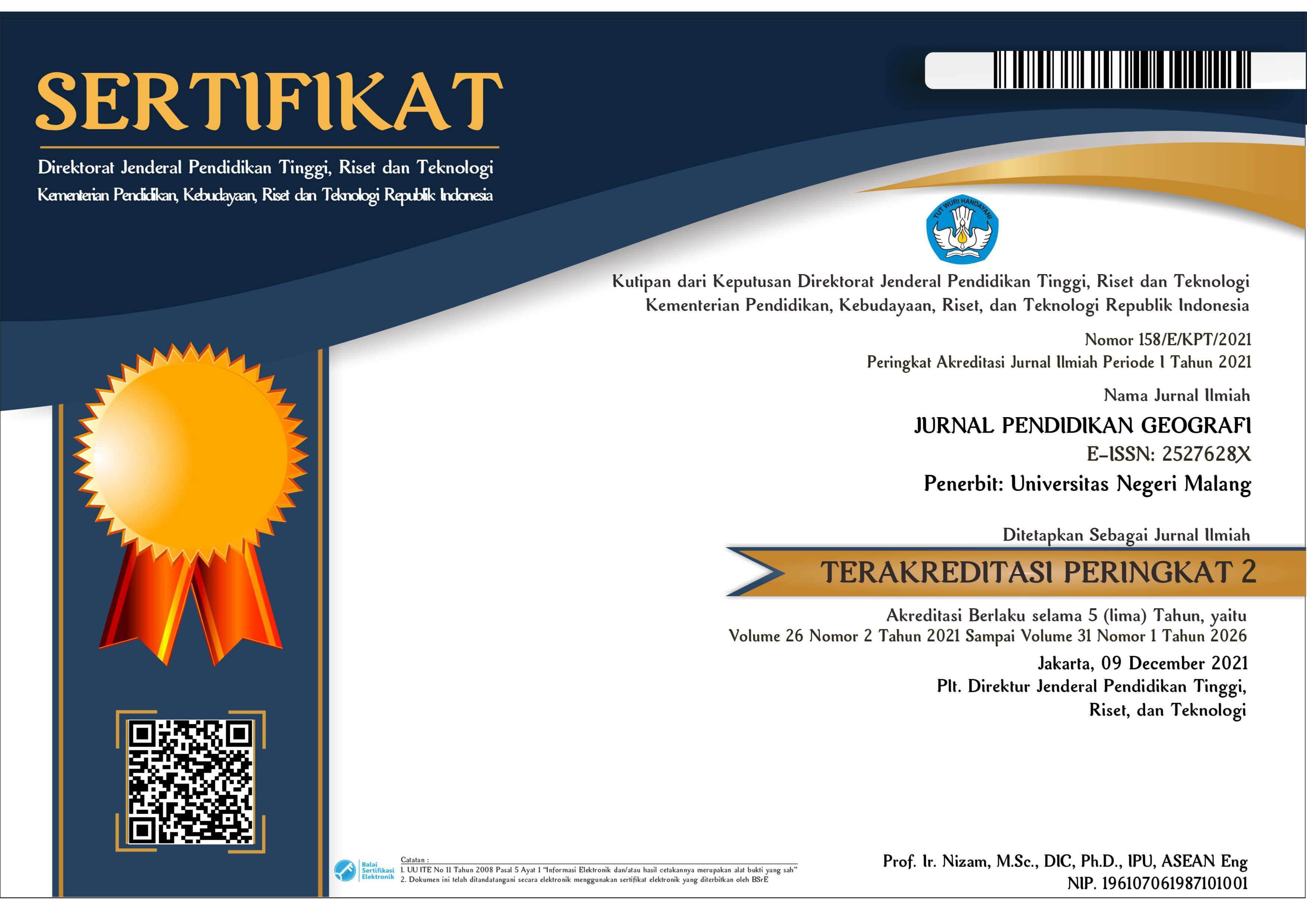A lesson learned from the success of disaster prone village transformation into a socioeconomic cultural safety net and environmental conservation
Abstract
Keywords
Full Text:
PDFReferences
Anggoro, A. D., Susanto, H., Arifin, R., Nugroh, O. C., Purwati, E., & Ridho, I. N. (2023). Pengayoman pemerintah pada masyarakat dalam mewujudkan desa tangguh bencana. JISIP (Jurnal Ilmu Sosial dan Pendidikan), 7(1), 588–594.
Anwar, Y., Maulana, M. F., Goma, E. I., & Wibowo, Y. A. (2022). Ketahanan masyarakat Desa Melintang terhadap bencana banjir Danau Melintang. Jurnal Pendidikan Geografi Undiksha, 10(2), 209–223.
Arifin, S., Wicaksono, S. S., Sumarto, S., Martitah, M., & Sulistianingsih, D. (2021). Disaster resilient village-based approach to disaster risk reduction policy in Indonesia: A regulatory analysis. Jàmbá: Journal of Disaster Risk Studies, 13(1), 1–9.
BNPB. (2015). Dokumen Kajian Risiko Bencana (KRB) Provinsi Jawa Tengah Tahun 2016-2020. Central Java: The National Agency for Disaster Countermeasure.
Boysen, O., Boysen‐Urban, K., & Matthews, A. (2022). Stabilizing European Union farm incomes in the era of climate change. In Applied Economic Perspectives and Policy (pp. 1–25). Wiley Online Library.
Chen, X., Tang, X., & Xu, X. (2022). Digital technology-driven smart society governance mechanism and practice exploration. Frontiers of Engineering Management, 1–20.
Chongbang, N. (2022). Local and social support practices in disaster management initiatives in Nepal. Transatlantic Journal of Multidisciplinary Research(TJMR), 4(1), 22–32.
Dejene, M., & Cochrane, L. (2022). Safety nets as a means of tackling chronic food insecurity in rural southern Ethiopia: what is constraining programme contributions? Canadian Journal of Development Studies/Revue Canadienne d’études Du Développement, 43(2), 157–175.
Dodd, W., Brubacher, L. J., Speers, S., Servano Jr, D., Go, D. J., & Lau, L. L. (2023). The contributions of religious leaders in addressing food insecurity during the COVID-19 pandemic in the Philippines: A realist evaluation of the Rapid Emergencies and Disasters Intervention (REDI). International Journal of Disaster Risk Reduction, 86(Januari), 103545.
Everly, G. S., Wu, A. W., Crumpsty-Fowler, C. J., Dang, D., & Potash, J. B. (2020). Leadership principles to decrease psychological casualties in COVID-19 and other disasters of uncertainty. Disaster Medicine and Public Health Preparedness, 767–769. https://doi.org/10.1017/dmp.2020.395
Fatmah, F., Lestari, F., & EL-Matury, H. J. (2022). Social, economic, cultural resilience, and discipline role of the North Sumatera Province Government in the COVID-19 management. Jurnal Pengelolaan Sumberdaya Alam dan Lingkungan (Journal of Natural Resources and Environmental Management), 12(2), 330–334.
Giena, V. P., Wahyuni, S., & Rahmawati, I. (2022). Pengaruh media audio visual terhadap sikap kesiapsiagaan masyarakat pada bencana banjir di Desa Tanjung Kecamatan Hamparan Rawang Provinsi Jambi. Jurnal Keperawatan Sriwijaya, 9(2), 13–17.
Hendrati, I. M., & Utami, A. F. (2022). Desa tangguh bencana sebagai upaya pemulihan mental dan kondisi sosial pasca bencana di Desa Bades. Literasi: Jurnal Pengabdian Masyarakat dan Inovasi, 2(2), 1419–1426.
Lai, X., & B, J. L. (2023). Research on challenge and development of smart community : Conceptual background. Proceedings of the 2022 International Conference on Sport Science, Education and Social Development (SSESD 2022), 24–32. Atlantis Press SARL. https://doi.org/10.2991/978-2-494069-13-8
Mehmood, R., Sheikh, A., Catlett, C., & Chlamtac, I. (2022). Smart societies, infrastructure, systems, technologies, and applications. Mobile Networks and Applications, 1–5.
Miyajima, H., Shigei, N., Miyajima, H., & Shiratori, N. (2022). Machine learning with distributed processing using secure divided data: Towards privacy-preserving advanced AI processing in a super-smart society. Journal of Networking and Network Applications, 2(1), 48–60.
Mueller, G., Barford, A., Osborne, H., Pradhan, K., Proefke, R., Shrestha, S., & Pratiwi, A. M. (2023). Disaster diaries: Qualitative research at a distance. International Journal of Qualitative Methods, 22, 16094069221147164.
Nashihah, D., Hanafi, I., Dhulhijjahyani, F., & Sciences, P. (2023). A socio-ecological systems approach disaster resilience for small island. Journal of Transformative Governance and Social Justice, 1(1), 23–30.
Okada, N. (2018). Adaptive process for SMART community governance under persistent disruptive risks. International Journal of Disaster Risk Science, 9, 454–463.
Okubo, H., Shimoda, Y., Kitagawa, Y., Gondokusuma, M. I. C., Sawamura, A., & Deto, K. (2022). Smart communities in Japan: Requirements and simulation for determining index values. Journal of Urban Management, 11(4), 500–518.
Orru, K., Hansson, S., Gabel, F., Tammpuu, P., Krüger, M., Savadori, L., … Schieffelers, A. (2022). Approaches to ‘vulnerability’ in eight European disaster management systems. Disasters, 46(3), 742–767.
Parvin, G. A., Dasgupta, R., Abedin, M. A., Sakamoto, M., Ingirige, B., Kibria, M. G., … Nakagawa, H. (2023). Disaster experiences, associated problems and lessons in southwestern coastal Bangladesh: Exploring through participatory rural appraisal to enhance resilience. Sustainable and Resilient Infrastructure, 8(sup1), 223–236.
Ramadhani, D. I., Damayanti, O., Thaushiyah, O., & Kadafi, A. R. (2022). Penerapan Metode K-Means untuk clustering desa rawan bencana berdasarkan data kejadian terjadinya bencana alam. JURIKOM (Jurnal Riset Komputer), 9(3), 749–753.
Rokhman, A., Tobirin, T., & Faozanudin, M. (2023). Smart village readiness using decision tree analysis the case of Banyumas Regency Indonesia. Proceedings of the 1st International Conference on Social Science (ICSS), 2(1), 96–105.
Sá, M. J., Serpa, S., & Ferreira, C. M. (2022). Citizen science in the promotion of sustainability: The importance of smart education for smart societies. Sustainability, 14(15), 9356.
Saiman, S., Hijri, Y. S., & Hadi, K. (2022). Pendampingan dan pelatihan peningkatan kapasitas desa tangguh bencana sebagai upaya Pengurangan Risiko Bencana (PRB) berbasis masyarakat di Desa Gajahrejo Kecamatan Gedangan Kabupaten Malang. Society: Jurnal Pengabdian Masyarakat, 1(2), 65–73.
Song, P., Zhao, J., Mubarak, S. M. A., & Taresh, S. M. (2022). Critical success factors for epidemic emergency management in colleges and universities during COVID-19: A study based on DEMATEL method. Safety Science, 145, 105498.
Volz, U. (2022). Climate-proofing the global financial safety net. Journal of Globalization and Development, 13(1), 1–30.
Wahyuni, A. T., Rachmawati, R., & Baiquni, M. (2022). Spatial analysis of socio-economic vulnerability in COVID-19 handling: Strategies for the development of smart society and smart economy. Information, 13(8), 366.
Wazwaz, A., & Kerbache, L. (2022). Towards smart society: Deployment of drones in optimizing the allocation of COVID-19 vaccines, the case of Qatar. Proceedings of the 5th European International Conference on Industrial Engineering and Operations Management. Rome, Itali.
Widagdo, A., Iswahyudi, S., Trilaksono, A., Jati, I. P., & Waluyo, G. (2021). Sosialisasi ancaman erupsi Gunung Slamet terhadap wilayah Kabupaten Banyumas-Jawa Tengah. Dinamika Journal: Pengabdian Masyarakat, 3(2), 47–55.
Zhao, L., Rasoulinezhad, E., Sarker, T., & Taghizadeh-Hesary, F. (2023). Effects of COVID-19 on global financial markets: Evidence from qualitative research for developed and developing economies. The European Journal of Development Research, 35(1), 148–166.
DOI: http://dx.doi.org/10.17977/um017v28i22023p145-157
Refbacks
- There are currently no refbacks.
Copyright (c) 2023 Jurnal Pendidikan Geografi: Kajian, Teori, dan Praktek dalam Bidang Pendidikan dan Ilmu Geografi

This work is licensed under a Creative Commons Attribution-ShareAlike 4.0 International License.
Jurnal Pendidikan Geografi: Kajian, Teori, dan Praktek dalam Bidang Pendidikan dan Ilmu Geografi is licensed under Creative Commons Attribution-ShareAlike 4.0 International License,
JPG Indexed By:
View My Stats








12.png)
